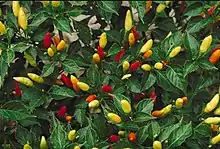Capsicum frutescens
Capsicum frutescens is a wild chili pepper having genetic proximity to the cultivated pepper Capsicum chinense native to the Amazon Basin.[1] Pepper cultivars of C. frutescens can be annual or short-lived perennial plants. Flowers are white with a greenish white or greenish yellow corolla, and are either insect- or self-pollinated. The plants' berries typically grow erect; ellipsoid-conical to lanceoloid shaped. They are usually very small and pungent, growing 10–20 millimetres (0.39–0.79 in) long and 3–7 millimetres (0.12–0.28 in) in diameter.[2] Fruit typically grows a pale yellow and matures to a bright red, but can also be other colors. C. frutescens has a smaller variety of shapes compared to other Capsicum species. C. frutescens has been bred to produce ornamental strains because of its large quantities of erect peppers growing in colorful ripening patterns.[1]
| Capsicum frutescens | |
|---|---|
 | |
| Tabasco peppers | |
| Scientific classification | |
| Kingdom: | Plantae |
| Clade: | Tracheophytes |
| Clade: | Angiosperms |
| Clade: | Eudicots |
| Clade: | Asterids |
| Order: | Solanales |
| Family: | Solanaceae |
| Genus: | Capsicum |
| Species: | C. frutescens |
| Binomial name | |
| Capsicum frutescens | |
Cultivars

Capsicum frutescens includes the following cultivars and/or varieties:
- Cabai Rawit,[3] from Indonesia,[4][5] used in hot Sambal.
- Hawaiian pepper
- Malagueta pepper
- Piri piri, also called African Bird's Eye or African devil
- Siling Labuyo, from the Philippines.
- Tabasco pepper, used to make Tabasco sauce
- Xiaomila pepper, from Yunnan province in China, one of the three most commonly used chilies in Chinese cooking (the other two being the C. annuum "Chao Tian Jiao" facing heaven pepper and the Two Vitex pepper).
Origins and distribution
_2.jpg.webp)
The Capsicum frutescens species likely originated in South or Central America. It spread quickly throughout the tropical and subtropical regions in this area and still grows wild today.[6] Capsicum frutescens is native to Central America and Northern and Western South America. C. frutescens may be related to C. chinense.[7]
Uses
Ethiopia

According to Richard Pankhurst, C. frutescens (known as barbaré) was so important to the national cuisine of Ethiopia, at least as early as the 19th century, "that it was cultivated extensively in the warmer areas wherever the soil was suitable."[8] Although it was grown in every province, barbaré was especially extensive in Yejju, "which supplied much of Showa as well as other neighboring provinces". He singles out the upper Golima river valley as being almost entirely devoted to the cultivation of this plant, where thousands of acres were devoted to the plant and it was harvested year round.[9]
Pests
Helicoverpa assulta is one of very few insects that can successfully feed on the red pepper because it can tolerate capsaicin.[11]
See also
References
- Carvalho, S. I. C.; Ragassi, C. F.; Bianchetti, L. B.; Reifschneider, F. J. B.; Buso, G. S. C.; Faleiro, F. G. (2014-09-12). "Morphological and genetic relationships between wild and domesticated forms of peppers (Capsicum frutescens L. and C. chinense Jacquin)" (PDF). Genetics and Molecular Research. 13 (3): 7447–7464. doi:10.4238/2014.September.12.11. ISSN 1676-5680. PMID 25222244.
- "Pacific Island Ecosystems at Risk (PIER)".
- Stevens, Alan M. (2004-01-01). A comprehensive Indonesian-English Dictionary. PT Mizan Publika. ISBN 9789794333877.
- "Tjabe Rawit information (German)". Retrieved 2012-02-26.
- Atlas tumbuhan obat Indonesia (in Indonesian). Niaga Swadaya. 2008-01-01. ISBN 9789796610655.
- "Capsicum frutescens". The Chillies. SoilMates. Retrieved 8 May 2011.
- Russo, Vincent M. (2012). Peppers: Botany, Production and Uses. Centre for Agriculture and Bioscience International. p. 17. ISBN 9781845937676. Retrieved 17 May 2017.
- Richard Pankhurst, Economic History of Ethiopia (Addis Ababa: Haile Selassie I University, 1968), p. 193.
- Pankhurst, Economic History, p. 194.
- "Digital Flora of Eastern Ghats - IISc".
- Ahn, Seung-Joon; Badenes-Pérez, Francisco R.; Heckel, David G. (September 2011). "A host-plant specialist, Helicoverpa assulta, is more tolerant to capsaicin from Capsicum annuum than other noctuid species". Journal of Insect Physiology. 57 (9): 1212–1219. doi:10.1016/j.jinsphys.2011.05.015. PMID 21704632.
